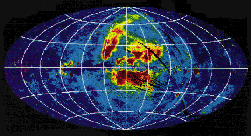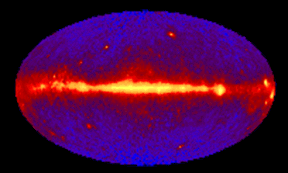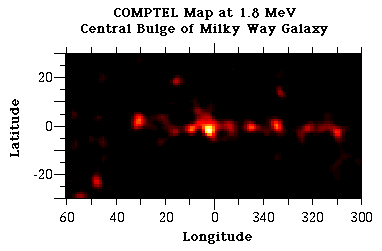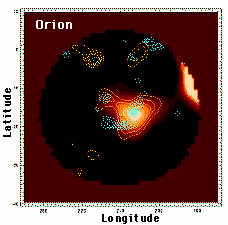The Diffuse High-Energy Background

When we look up on a clear night, we see the beautiful twinkling of stars and planets amid a black sky. If we could see the same sight with X-ray or gamma ray eyes, we'd still see bright points, but the sky would no longer be dark. Instead, it would glow faintly. This is the diffuse high-energy background: X-ray and gamma-ray light from all over the sky. By looking at different wavelengths of X-rays and gamma rays, which correspond to different energies, we can find out what causes this amazing background glow.
X-ray Diffuse Background
At low X-ray energies (about 1/4 keV), the sky glows with radiation from hot gas filling some of the space between the stars. This gas has a temperature of about 1 million degrees and is heated in two ways: by supernovae, which leave shining remnants of hot gas behind; and by the hot winds of massive young stars, which heat surrounding gas and form stellar wind bubbles.
At higher X-ray energies (above 1/2 keV), the source of the diffuse background changes considerably. While emission from supernova remnants and stellar wind bubbles is still visible, it is less dominant than at lower energies. Much of the background radiation becomes isotropic (that is, it looks the same in all directions). Scientists believe the radiation comes from outside our Milky Way Galaxy, since radiation from within the Galaxy would be brighter in some places and dimmer in others, due to our galaxy's shape.
Above 1 keV, most of the "diffuse" background is not truly diffuse in origin at all, but comes from many distant extragalactic objects. We know this from "deep" observations of the diffuse X-ray background. In astronomy, a "deep" observation means that a detector looks at a given point in space for a very long time. Using the deepest ROSAT observations, over 60 % of the 1 - 2 keV diffuse background has been resolved into very distant, separate sources, typically quasars.
Gamma-ray Diffuse Background
While there are many individual point sources of gamma rays, there is also a significant amount of gamma-ray light from gas in our own Milky Way Galaxy. Gamma-ray light from this gas stretches out in a band across the sky, comprising much of the diffuse gamma-ray background. The remaining gamma-ray background light we see comes from far outside our galaxy: it's the faint glow of the rest of the Universe, covering all the sky beyond the Milky Way.

Within our galaxy, there are actually several different types of diffuse gamma-ray background radiation. The image above shows one type. Here, the yellow and red band through the center of the image is the high-energy glow caused by cosmic rays interacting with interstellar gas. The gas, heated by the cosmic rays, gives off gamma rays with energies > 100 MeV. Similarly glowing gas has been seen in the nearby galaxy known as the Large Magellanic Cloud.
Another type of diffuse gamma-ray emission in our galaxy is pictured in the image below. This image shows the central region of our Milky Way Galaxy, using data from the Compton Gamma Ray Observatory's COMPTEL instrument.

In this COMPTEL image, only one type of gamma-ray light is shown: the light given off by a radioactive form of Aluminum, called 26Al. Scientists theorized that this form of aluminum was created by novae or in massive stars, and therefore they expected a lot of it near the galactic center (where the concentration of massive stars would be highest). They also expected 26Al to be distributed smoothly and symmetrically on each side of the galactic center, since that's generally how the stars were distributed, too. Interestingly, the 26Al radiation detected by COMPTEL has a more complicated structure. The emission is very localized or "clumpy" and not as bright towards the center of the Galaxy as expected. Explaining these results will require both new theoretical insights and more sensitive observations from future gamma-ray instruments.
Yet another source of diffuse gamma-ray radiation in our galaxy is the violent interaction of matter and anti-matter. Certain galactic phenomena produce positrons, the anti-matter equivalents of electrons. Positrons have a positive electric charge and are made of anti-matter. Electrons have a negative charge and are made of matter. When positrons and electrons come into contact, they destroy each other violently, an event called "pair annihilation." Pair annihilation releases a burst of gamma-ray energy of exactly 511 keV. These gamma rays are part of the diffuse gamma-ray background in our galaxy.
Many other, less violent processes also produce gamma rays at specific energies. Taken together, these all contribute to the diffuse gamma-ray background in our galaxy. For example, the image below shows an area in the constellation Orion where gamma rays were detected in a range of energies between 3 and 7 MeV. Just as 511 keV gamma rays are the "signature" of pair-annihilation, the gamma rays in this picture are also "signatures" of certain events. In this case, though, the specific gamma-ray energies represent more mundane things, like the presence of carbon and oxygen in the interstellar gas of the Orion region.

The diffuse gamma-ray emission from outside our galaxy may be due to the combined light of far-away individual objects. The objects are most likely active galaxies (AGN), a type of galaxy that emits unusual amounts of gamma-ray and X-ray radiation. These are very similar to quasars, the main source of the X-ray background outside our galaxy.
The sensitive study of the diffuse gamma-ray background is a field which is only beginning to be realized with current gamma-ray instruments. Future observations will provide important insights into one of the most fundamental questions astronomy can address - how did the matter we see all around us evolve?


